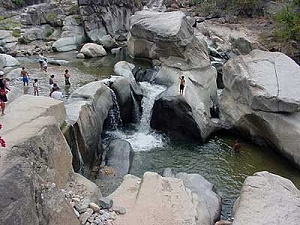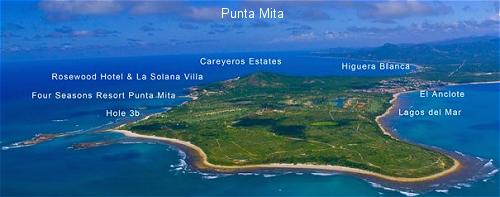


| |
 Art & Travel in Mexico: take a driving vacation to beaches from Puerto Vallarta on the Mexican Riviera Art & Travel in Mexico: take a driving vacation to beaches from Puerto Vallarta on the Mexican Riviera  | |
|
| |
Bay of Banderas - vacation getaway with many hotels, resorts and villa rentalsBay of Banderas, or Bahia de Banderas (Bay of Flags), is a great vacation destination for winter getaways. There are many flights that service the Puerto Vallarta airport, often flying direct from your departure city. As the largest bay in Mexico, Thought by some to be the rim of a long extinct super volcano, it is the 7th largest bay in the world (and the deepest), supporting numerous communities around its perimeter, including Bucerias, Punta Mita, and Mismaloya. The major city, Puerto Vallarta (pop 350,000), is very clean and vibrant with a lot to offer, but if you prefer a quieter time, there are plenty of accommodation options at the smaller communities around the bay. The highway around the southern portion of the bay turns inland and climbs into the mountains at Boca de Tomatlan, leaving a good third of the bay without road access. There are several communities beyond that point, such as Yelapa and Quimixto, that can only be reached by boat, if you really want to get away from it all. Interestingly enough, the bay doesn't have a great deal of Colonial history, and has developed from a quiet fishing village into a populated resort center only recently, starting in the early '60's. That was when John Huston shot the film 'Night of The Iguana' in the little village of Mismaloya, and many who came at that time recognized the natural beauty of the area and stayed on. Both Elizabeth Taylor and Richard Burton maintained residences there for many years, and their homes in Puerto Vallarta are now a tourist attraction (including the bridge over the street that Burton built between their houses). John Huston also spent the last of his years there, as he fell in love with the area too. The set of the film is still in place at Mismaloya, and you can go to the John Huston Restaurant for dinner, and tour the set.
Because the high mountains are close to the ocean, capturing the rainfall in the wet season, it is the only major city on the central coast that is officially within the jungle vegetation zone, and the flowers, plants and trees are truly magnificent. The jungle is not thick and can be walked through quite easily, but it nevertheless creates a verdant paradise in this region, unlike any other place I've seen on the coast. The continuation of the coastal highway (highway 200) to the south is cut right into the side of the mountains, twisting and winding above the bay, often hundreds of feet up the steep faces, until it turns inland at Boca de Tomatlan, heading for the Jalisco coast (Costa Alegre). The rich valley farmland north of the city, bordered by the Sierra Vallejo mountain range to the north, spills up the Valle de Banderas, following the windings of the Rio Ameca, which provides a continuous water supply for the abundant field crops. You'll get a good view of this when you arrive by plane, as they usually drop down through the valley to land into the prevailing wind that blows off the ocean. The Rio Ameca is the border between the states of Nayarit (to the north) and Jalisco (to the south); it is also the division between Mountain and Central time zones, so if you're heading north, watch your return flight times as the aeropuerto is south of the river (on Central time). Moving around the bay to the north side, there are some nice little communities that we thought were very pleasant. Once you get past the megaresort area of Neuvo Vallarta, you'll come to the town of Bucerias. There are numerous hotels, bungalows, villas, resorts and facilities in Bucerias, and it is a 'last chance' stop for gas and ATM cash for quite a ways if you're heading north, including going to Sayulita or San Pancho. The next opportunity for gas and money is close to Rincon, although there is a Pemex gas station if you turn off to Punta Mita, just after the exit.
Which is exactly what we did, discovering the next very scenic little town of La Cruz de Huanacaxtle (Cross of the Huanacaxtle Tree), built on a slope that runs down to ocean where there is a sheltered harbour. My understanding is that it has received the official go-ahead to build a large marina, so watch for changes in this area. Moving around the bay to the northern extreme, you'll pass numerous other resorts and hotels, such as the Palladium. Finally, you'll arrive at the sprawling resorts at Punta Mita, including the Four Seasons Resort Hotel complex. This area is the latest FONATUR development area, like Cancun, Cabo and Ixtapa, sponsored by the Mexican Government, and it has a new divided four lane highway that runs along just inland of the coast most of the way to Sayulita. This is the place to go if you want to spend lots of money for a recreational holiday at an isolated megaresort, but you won't find much in the way of regular Mexican folks and culture out there. |
YOU ARE HERE > HOME > BAY OF BANDERAS
|
| TRAVEL & ART in MEXICO - MENU |
HOME COSTA AZUL Sayulita Bungalow Rentals Villa Rentals San Francisco (San Pancho) Rincon de Guayabitos Chacala BAY OF BANDERAS Puerto Vallarta Puerto Vallarta Via Boeing 787 Soon COSTA ALEGRE Barra de Navidad Melaque Cuastecomate Tenacatita Cihuatlan - Carlos Santana walked here COLIMA STATE Manzanillo Colima City Volcano of Fire Colima Volcano Satellite Photo MAYAN RIVIERA MEXICO WEATHER
This website was created with XSitePro and is hosted by our sister company - AeroHOST Web Systems
Copyright © 2002-2008 - Mexico Art and Travel - All Rights Reserved

 it has approximately 100 miles of coastline, offering a large variety of villa, resort and hotel accommodations - from super luxury resorts such as the Four Seasons at Punta Mita, to affordable budget bungalows in Bucerias. Puerto Vallarta is the major city, situated roughly halfway around the bay, with a wide selection of villas, hotels and resorts to choose from.
it has approximately 100 miles of coastline, offering a large variety of villa, resort and hotel accommodations - from super luxury resorts such as the Four Seasons at Punta Mita, to affordable budget bungalows in Bucerias. Puerto Vallarta is the major city, situated roughly halfway around the bay, with a wide selection of villas, hotels and resorts to choose from. The city of Puerto Vallarta is sandwiched between the Sierra Cuale mountains and the ocean, and the southern end of the city runs out of flat land where the mountains close in and drop straight into the ocean. It is blessed with a constant supply of clean, fresh water running out of the mountains, and there are a number of places in the rivers, such as Chico's Paradise (pictured at left, just above Boca de Tomatlan), where you can go for a nice swim in fresh water pools (unusual for Mexico).
The city of Puerto Vallarta is sandwiched between the Sierra Cuale mountains and the ocean, and the southern end of the city runs out of flat land where the mountains close in and drop straight into the ocean. It is blessed with a constant supply of clean, fresh water running out of the mountains, and there are a number of places in the rivers, such as Chico's Paradise (pictured at left, just above Boca de Tomatlan), where you can go for a nice swim in fresh water pools (unusual for Mexico). 
